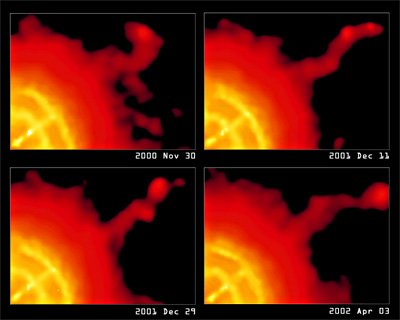Using NASA’s orbiting Chandra X-ray Observatory, astronomers have captured stunning views of a twisting column of x rays whipping around a pulsar. Propelled by voltages 100 million times more powerful than a lightning bolt and traveling near half the speed of light, such highly erratic jets have never been seen before.
Snapping a series of x-ray images of the 1,000-light-year-distant Vela pulsar, a team of Pennsylvania State University researchers has made a short movie spanning a two-and-a-half-year period that brings this spinning dead star to life. The time-lapse animation clearly shows that, in a span of a few weeks, a gigantic serpentine jet of high-energy particles bends and coils in all directions.
“This jet is half a light-year in length and is shooting out ahead of the moving pulsar,” said George Pavlov, lead author of a report in the July 10 issue of The Astrophysical Journal. “The most striking thing about this jet is how rapidly it changes both its shape and brightness. Such strong, fast variability has never been observed in astrophysical jets.”
“Imagine a firehose lying on the ground,” explains co-investigator Marcus Teter. “After you turn on the water, you will see different parts of the hose kinking up and moving rapidly in different directions, pushed by the increased pressure at the bends in the hose. The Vela jet resembles a hose made of magnetic fields, which confines the electrically charged particles.”
Pavlov and his teammates believe these intimate observations also suggest that the bright arcs encircling the Vela pulsar, once thought to be equatorial rings, are shockwaves resulting from the jet smashing into clouds of dust and gas surrounding the stellar corpse.
With Vela showing incredibly fast changes in its jet morphology, this novel cinematic study will begin to unveil the inner clockwork of pulsars. Astronomers hope the observations will go one step further and even shed light on how bizarre jet formations work around more energetic objects like supermassive black holes. But, as team member Oleg Kargaltsev adds, “Those jets may also vary, but on time scales of millions of years, instead of weeks as in the Vela pulsar jet.”










